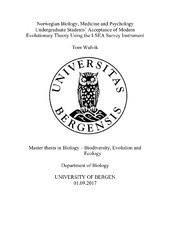Norwegian Biology, Medicine and Psychology Undergraduate Students´ Acceptance of Modern Evolutionary Theory Using the I-SEA Survey Instrument
Master thesis

Åpne
Permanent lenke
https://hdl.handle.net/1956/16812Utgivelsesdato
2017-11-02Metadata
Vis full innførselSamlinger
Sammendrag
584 undergraduate students from three disciplines and four public universities in Norway were sampled during the spring of 2014 for acceptance of modern evolutionary theory using the I-SEA survey instrument developed by Nadelson and Southerland (2012). Using a scale from one to five where five signals strong agreement with modern evolutionary theory, overall acceptance was 4.49. Differences where found between majors of biology, medicine and psychology, though all the differences were small (as indicated by Cohen´s d). A small effect of taking an evolution course on acceptance rates was found. These results are discussed within the framework of understanding why there are different levels of acceptance between countries, teaching modern evolutionary theory in the classroom and differences in acceptance between academic disciplines. Norway and other Nordic countries have high levels of acceptance of evolution compared to many other Western countries. Studies show that countries with high levels of science literacy, GDP and school-life expectancy, and with low levels of religiosity have the highest acceptance rates. While biology majors are familiar with evolutionary theory in their syllabus and required readings, studies show that majors in medicine and psychology are much less familiar with Darwin´s theory of evolution by natural selection. Students and staff reject evolutionary theory for cognitive, methodological, coherence and emotional reasons. In a Chapter 2 review arguments in favor of why biology, medicine and psychology should incorporate modern evolutionary theory are put forth, as well as to expand upon why students and staff reject evolutionary theory, and how to persuade students to accept it. Modern evolutionary theory has a lot to offer biology, medicine and psychology in terms of establishing a casually unifying framework that unites all disciplines dealing with living organisms and their complex adaptations. A major concern of science educators is how to effectively teach modern evolutionary theory to students, especially those with a religious background. Some useful, practical tips and suggestions are discussed.